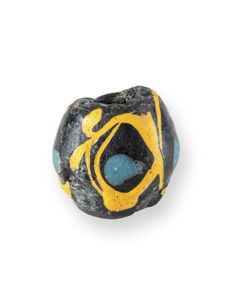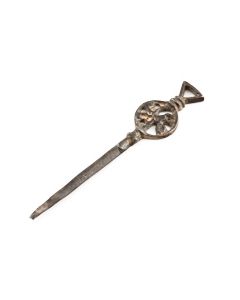Middle Ages Europe - Northern Europe - Sold antiquities
Archive of sold antiquities
All artefacts sold in our gallery are fully documented in our online archive and database. Being a specialist ancient art dealer, preserving also the more recent history of each and every piece sold in our shop is at our heart. That is particularly useful for artefacts that changed owners in the meantime. Information that may have been lost in the process can be easily restored from our archives. Please do not hesitate to contact us if you need further information about ancient items that have been sold in our gallery. We can help you with reconstructing the history of ownership for those items. All information about our customers will be kept confidential, of course.-
 Anglo-Saxon bow brooch
Anglo-Saxon bow broochA find from the Isle of Wight from the Migration Period. Beautiful testimonial of the settlement of Britain by the Anglo-Saxons.
Price: on request Anglo-Saxon gilt bow brooch
Anglo-Saxon gilt bow broochA find from the Isle of Wight from the Migration Period. Beautiful testimonial of the settlement of Britain by the Anglo-Saxons.
Price: on request Anglo-Saxon bow brooch
Anglo-Saxon bow broochA find from the Isle of Wight from the Migration Period. Beautiful testimonial of the settlement of Britain by the Anglo-Saxons.
Price: on request Glass bead with polychrome decoration
Glass bead with polychrome decorationLarge bead made of opaque dark blue glass decorated with yellow lines and light blue eyes.
Price: on request Medieval gilt finger ring
Medieval gilt finger ringThe ring from the late Middle Ages was found in England. The silver body and the gold plating are in excellent condition. Appraised at the British Museum, published in the Portable Antiquities Scheme database.
Price: on request Large Visigoth bow brooch
Large Visigoth bow broochImpressive fibula of the Visigoths from the Migration Period. With five originally preserved glass inserts.
Price: on request Roman and medieval potsherds from the Rhineland
Roman and medieval potsherds from the RhinelandFragments of Roman and medieval pottery. Finds from the Roman city of Novaesium, today's Neuss in Germany, an early Roman foundation and with this one of the oldest cities in Germany.
Price: on request Viking stirrup mount
Viking stirrup mountOpenwork bronze plate from the 11th century. It was once attached to a horse harness strap. The beautiful decorations are typical of the art of the Vikings.
Price: on request Tall bone pyxis
Tall bone pyxisInteresting cylindrical vessel with rich decoration. From antiquity or early Middle Ages.
Price: on request Bavarian drinking vessel from the Early Middle Ages
Bavarian drinking vessel from the Early Middle AgesRare and beautifully stamp decorated pottery of the early Baiuvarii around 600 AD. From a find in Riekofen in Bavaria.
Price: on request Haarnadel
HaarnadelNiederlande, um 1450. Fein gearbeitete, verzierte Haarnadel. Mittelalter.
Price: on request Haaken für Kleidung
Haaken für KleidungNiederlande, um 1450. Derlei Haaken wurden an Stelle von Knöpfen verwendet. Mittelalter. Preis pro Stück. Freie Wahl.
Price: on request

 Kleiderhaken, 16. Jd., 3 Stück
Kleiderhaken, 16. Jd., 3 StückBronzearbeit des ausgehenden Mittelalters, Niederlande. Biblische Darstellung von Jonah und dem Wal. Je 3cm lang.
Price: on request Antiker Spinnwirtel aus Bein
Antiker Spinnwirtel aus BeinSehr kunstvolle Verzierungen, perfekte Erhaltung. Spätantike bis frühes Mittelalter, Fund aus dem Rheinland.
Price: on request GERMANICORUM SCRIPTORUM
GERMANICORUM SCRIPTORUMSehr seltenes Sammelwerk bedeutender Historien. FOLIO aus dem Jahre 1584
Price: on request Artefakte aus Eisen
Artefakte aus EisenRömerzeit bis Neuzeit, nicht näher bestimmt. Zwei antike Schlüssel, Nägel und Sporen. 2012 aus dem Privatbesitz T. Bak erworben, an welchen in dritter Familiengeneration die Sammlung von Professor Josef Lambinet übergegangen ist. Nach Angaben und Dokumenten von Prof. Lambinet wurden die Objekte um 1920 in Mainz gefunden, unmittelbar an der römischen Wasserleitung Mainz-Zahlbach. Siehe nähere Fundortdokumentation bei Art.nr. AR1925.
Price: on request Scherben eines mittelalterlichen bis neuzeitlichen Tongefäßes
Scherben eines mittelalterlichen bis neuzeitlichen TongefäßesFragmentarisch erhalten. Die drei großen Scherben passen aneinander und Bilden einen Teil vom Gefäßkörper. Die übrigen Gefäßteile fehlend. Zusammengesetzt ca. 9,2cm Höhe. 2012 aus dem Privatbesitz T. Bak erworben, an welchen in dritter Familiengeneration die Sammlung von Professor Josef Lambinet übergegangen ist. Nach Angaben und Dokumenten von Prof. Lambinet wurden die Objekte um 1920 in Mainz gefunden, unmittelbar an der römischen Wasserleitung Mainz-Zahlbach. Siehe nähere Fundortdokumentation bei Art.nr. AR1925.
Price: on request Mittelalterliches bis neuzeitliches Tongefäß
Mittelalterliches bis neuzeitliches TongefäßFragmentarisch, Gefäßkörper erhalten, Gefäßoberteil fehlend. Aus mehreren Stücken restauriert. An dem Gefäßfuß ist Glas angeschmolzen, wie es sich bei zahlreichen Objekten aus der Fundgruppe fand. Die Herkunft ist ungeklärt. 12,3cm Höhe. 2012 aus dem Privatbesitz T. Bak erworben, an welchen in dritter Familiengeneration die Sammlung von Professor Josef Lambinet übergegangen ist. Nach Angaben und Dokumenten von Prof. Lambinet wurden die Objekte um 1920 in Mainz gefunden, unmittelbar an der römischen Wasserleitung Mainz-Zahlbach. Siehe nähere Fundortdokumentation bei Art.nr. AR1925.
Price: on request Mittelalterliches bis neuzeitliches Tongefäß
Mittelalterliches bis neuzeitliches TongefäßMit sehr schöner Gesichtsdarstellung und Umschrift in gutem Zustand. Fragmentarisch, Gefäßkörper erhalten, Gefäßoberteil fehlend. 9,6cm Höhe. 2012 aus dem Privatbesitz T. Bak erworben, an welchen in dritter Familiengeneration die Sammlung von Professor Josef Lambinet übergegangen ist. Nach Angaben und Dokumenten von Prof. Lambinet wurden die Objekte um 1920 in Mainz gefunden, unmittelbar an der römischen Wasserleitung Mainz-Zahlbach. Siehe nähere Fundortdokumentation bei Art.nr. AR1925.
Price: on request Schleifstein der Wikinger
Schleifstein der WikingerZum Schärfen eingesetzter Schieferstein aus der Wikingerzeit. Nutzungsspuren an allen vier Längsseiten. 9. bis 11. Jh. n. Chr. Fund bei Roskilde, Dänemark.
Price: on request Discursus politico-iuridicus
Discursus politico-iuridicusBrisantes, verschlüsseltes politisches Werk, steht auf dem Index der heiligen Inquisition. Erschienen im Jahr 1612.
Price: on request Schmucknadel mit Vogelmotiv
Schmucknadel mit VogelmotivSchwertartige Nadel mit aufwendig verziertem Kopfende, das einen stilisierten Vogel zeigt. Der Stil weist in die Spätantike oder das frühe Mittelalter. Vermutlich ein Fund aus Frankreich.
Price: on request Early Merovingian silver fibula
Early Merovingian silver fibulaMuseumswürdiges Exemplar aus dem 5. bis 6. Jh. n. Chr. Fränkischer Fibeltyp mit typischer rautenförmiger Fußplatte. Sehr kunstvoll verziert mit Vergoldung, Schmucksteinen und stilisiertem Tierkopf.
Price: on request Visigoth bronze fibula
Visigoth bronze fibulaAus der prägenden Zeit der Völkerwanderung. Fund aus England. Import oder lokale Imitation eines Fibeltyps der Westgoten bzw. Visigothen aus dem 5. bis 6. Jh. n. Chr.
Price: on request

